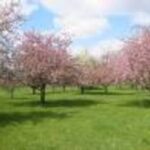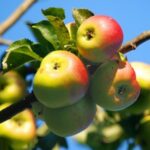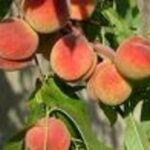There is a place for dwarf fruit trees in the garden. Especially when the garden is small, leaving no room for growing what we refer to as the home orchard. On the other hand, they are valued just as much and sometimes more for their attractiveness or ‘cuteness,’ whichever way you want to describe it, than for their fruit production.
I am not insinuating that the fruit is not good. It really is and I have found that dwarf peaches and nectarines will produce much earlier than the regular large trees. I mentioned last week that you can’t expect much in the way of fruit production from large trees for at least four or five years from time of planting bare root but I have seen the dwarfs starting with fairly good crops in three years. Coming now to deciding which dwarf fruit tree to use I can only give you my opinion and in making my choice. There are certain trees that will not perform at their best because of our mild winter climate.
Apples, pears and cherries are three good examples. Oh yes, they’ll grow but the fruit tastes more like channel than fruit. There are two dwarfs I believe are worthy of a place in every garden where space is at a premium and that’s what we’re talking about today. I have in mind my old favorite Bonanza peach which I think is still at the top of the list with Nectarina a comparatively new nectarine running a close second.
If you’re cramped for space, try growing these conversation pieces in redwood tubs. When the Bonanza peach first hit the market about 10 years ago I grew two (one each in a 20-inch redwood tub) and I think I enjoyed the flowers and the long-season attractiveness of the shrub just as much as I did the fruit. Frankly, I hated to even pick the fruit because visitors would rave over the unbelievable sight.
Now, I must admit I have not grown the new Nectarina but I have had reports from growers and I am sure it’s going to be another winner. This new dwarf, like Bonanza peach is a true genetic dwarf so you don’t have to worry about the tree taking off into orbit as some of the oldtime ‘dwarfs’ would do. By the way, Bonanza starts its fantastic display of softpink double flowers about the early part of June followed by good crops of full-sized yellow-skinned, juicy, yellow-fleshed freestone peaches with a delightful flavor.
The new Nectarina, like the Bonanza peach, is a neat compact permanent dwarf, beautifully ornamental and believe it or not, will produce amazing crops when less than three feet tall. The juicy, firm, orange-colored flesh has a sprightly, exhilarating flavor and usually follows Bonanza by about three weeks.
If you have space for a small home orchard and fruit is your first choice, start off with the old regular reliables. This list would include the Royal apricot, Babcock and Elberta freestone peach, Satsuma and Santa Rosa plum, Goldmine nectarine, Brown Turkey fig and Hachiya persimmon. Moving into the latter part of January we will find bare root planting reaching its peak during the next four weeks and most experienced gardeners try to have all this type of planting completed by the end of next month, If you can do this earlier, by all means do so.
Source:
http://miniatures.about.com/od/livingminiatures/a/dwarfruit.htm





